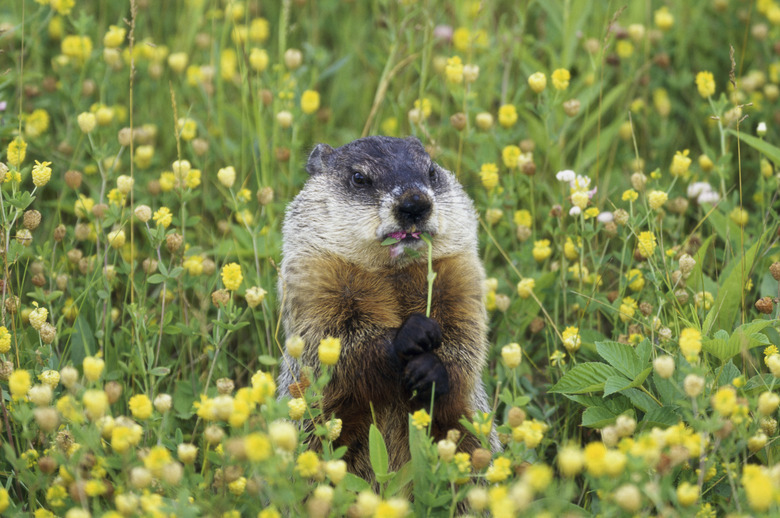How To Identify If I Have Moles Or Groundhogs In My Yard
We may receive a commission on purchases made from links.
Little can vex a proud homeowner as deeply as the discovery of a dizzying maze of holes and tunnels in a beautifully kept lawn. While the dastardly culprit is likely a mole or a groundhog, also called woodchuck, it's important to make a correct identification to prevent further damage to your property. The toughest part of this battle is knowing your enemy, but it has left clues as to its identity.
Moles and Groundhogs: Physical Appearance
Moles and Groundhogs: Physical Appearance
The most common moles in home landscapes is the eastern mole. Its range consists of the eastern and central portions of the U.S. Eastern moles are 5 1/2 to 8 inches long. The fur is charcoal gray with white or orange patches on the underside. The front feet are large, webbed, and with claws for digging, while the snout is short with prominent nostrils. Moles do have eyes but they are hidden under their fur. They have no external ears and a short, hairless tail.
Groundhogs are much larger with a head and body averaging 16 to 20 inches long and a furry tail that is 4 to 7 inches in length. They have grayish-brown fur, short legs on a stout body, and front feet with long, curved claws for digging burrows. Groundhogs' range consists of northward into areas of Alaska, southward to northern Alabama and southern Virginia, and westward into northern Idaho.
Their Daily Lives
Their Daily Lives
Moles spend most of their life underground and rarely come to the surface. They dig long tunnels from their dens while hunting insects such as white grubs and earthworms, but they also eat some plant material such as tubers and seeds. Moles are active year-round.
Groundhogs come out of their dens to feed mainly in the early morning and evening hours. They are herbivores that eat a variety of vegetables and grasses. Groundhogs can be active during daylight hours and are sometimes observed basking in the sun on warm days. They communicate through distinctive sounds, including whistles, squeals, clicks, and barks. Groundhogs hibernate during winter months.
Distinctive Mole and Groundhog Burrows
Distinctive Mole and Groundhog Burrows
Moles dig tunnels about 5 to 8 inches below the surface of the soil. The tunnels are about 1 1/2 inches in diameter and connect to underground dens or chambers. The excavated soil is often thrown out, creating small mounds of dirt or molehills that are usually 4 to 8 inches high. The mole tunnels can be identified by ridges in the surface of the soil that can be followed.
The main opening of a groundhog burrow is 10 to 12 inches with a mound of dirt in front. They are often located near a tree base, building foundation, or fence. Secondary entrances may be present that do not have the thrown-out dirt mounds. Tunnels excavated by groundhogs are as deep as 5 feet and range in length from 8 to 66 feet. The tunnels are too deep to be followed like mole tunnels.
Surveying the Damage
Surveying the Damage
Moles are insectivores that eat harmful lawn pests such as white grubs, but many people do not like the unsightly raised tunnels and molehills they create in manicured landscapes. They may damage plant roots as they dig tunnels. Voles and mice often use excavated mole tunnels as passageways and cause damage by eating seeds, roots, and tubers.
Groundhog mounds and burrows damage lawns, and groundhogs gnaw or claw trunks and stems of fruit trees and ornamental shrubs. They eat a variety of garden plants such as beans, squash, and peas. Damage to plants that occurs between early November and late February is likely caused by deer or rabbits since groundhogs are hibernating at this time. Groundhogs rarely carry rabies and are generally not aggressive but will fight back if cornered by a dog.
Warning
If you or your pet is bitten by a groundhog, seek treatment for rabies as a precaution.
Pest Control Options
Pest Control Options
Check the legal status of moles and groundhogs in your area before attempting control methods, particularly the removal of nuisance animals. Many states have wildlife protection laws that limit the methods you can use. There are nonlethal techniques that involve habitat modification or exclusion.
Wire mesh fences that are 24 inches high and buried 12 inches in the ground can protect small areas, such as seed beds, from moles. Groundhogs require a fence at least 3 feet high and buried 2 inches in the ground. Remove food sources and disrupt burrows and tunnels to further discourage activity. Burrow entrances constructed by groundhogs can be closed off when empty, and mole tunnels can be packed down with a roller.
Consider tolerating the presence of the mole or groundhog. Moles eat lawn pests and help to aerate the soil. Groundhogs are a natural part of the ecosystem and a food source for foxes, hawks, and eagles.
Tip
Evict groundhogs between early July and late September. Avoid other times of the year as there may be young developing within the burrow.
